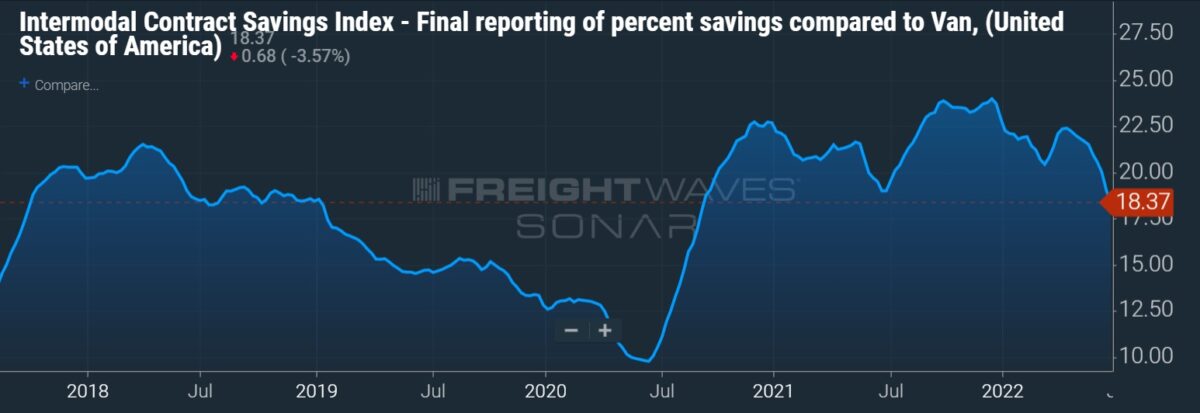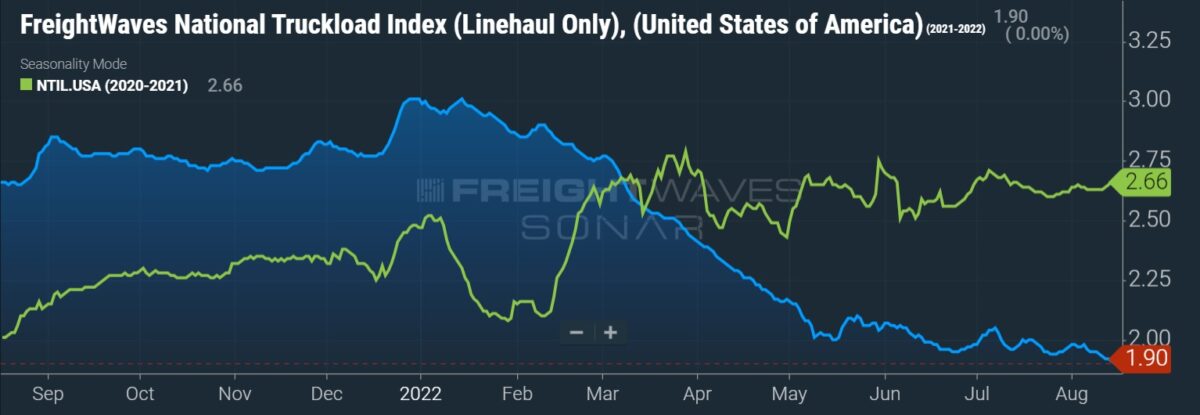Management from J.B. Hunt Transport Services voiced continued commitment to the company’s intermodal growth ambitions and the large investments it has made in the mode during an investor conference this week. Even as historic bottlenecks on the rails and an uptick in truck capacity present headwinds to demand for the service, the company is confident in its long-term plans.
Improvement to intermodal service likely a 2023 event
Appearing at Deutsche Bank’s (NYSE: DB) annual transportation conference on Tuesday, J.B. Hunt’s (NASDAQ: JBHT) management team was adamant that demand for its intermodal offering remains strong but acknowledged service needs to pick up in order to capture incremental volume.
During the second quarter J.B. Hunt’s rail partners saw further deterioration in service. Train speeds at Norfolk Southern (NYSE: NSC) were down 11% and flat at BNSF (NYSE: BRK.B). Dwell times were up 20% and 12%, respectively. Not much relief has been seen in the first few weeks of the third quarter as dwell times are up 16% and 10%, respectively. Velocity has improved ever so slightly in recent weeks at BNSF (up 1%) but Norfolk Southern (down 14%) has seen further declines.
At a Wednesday press conference, Port of Los Angeles Executive Director Gene Seroka said nearly 34,000 cargo containers destined for rail remained at the docks and more than 20,000 of those have been sitting for at least nine days. In the past, the port would only have roughly 9,000 containers waiting for rail service.
“The continued effort to get better velocity and service out of our rail product will only deliver significant growth demand from our customers,” said Darren Field, EVP and president of intermodal at J.B. Hunt. “We continue to hear our shippers tell us that they want more from intermodal but they need better service.”
Field said a loosening in truckload capacity has pulled “a little bit of business away from intermodal,” but he believes the demand is there when service improves.
Internally, J.B. Hunt targets an on-time percentage threshold of 90% and keeps track of the additional time a load was out compared to the expected delivery window. In a healthy market the number of incremental hours incurred can run between high-single and low-teen digits. Currently, it’s more than two days.
“We have seen that bottom out,” Field continued. “Yeah, it’s gotten better but it’s still historically the worst we’ve seen. We never saw numbers like this before the pandemic.”
Container turns across the company’s intermodal fleet remain at depressed levels. During the second quarter, the company moved 1.65 loads per container each month (five loads per box for the quarter). Quarterly box turns were 5.7x or better in the years leading up to the pandemic. That’s an annual shortfall of roughly three loads per container on a fleet of 110,000 and growing. At $3,400 in revenue per load, there’s roughly a $1 billion top-line opportunity hanging out there, assuming the demand is truly there.
However, the bears say it’s network congestion that is requiring J.B. Hunt to run extra equipment and that if service levels improve the company could actually see lower load counts per box on its larger fleet size (up almost 14,000 units since the end of 2019). The implication is that demand really isn’t there.
Further, the recent high watermark for revenue per load will likely moderate as fuel prices recede and as accessorial charges to customers holding boxes too long dissipate, both of which present headwinds to the aforementioned revenue opportunity.
The demand question likely won’t be answered this year. Field said the labor market has been a challenge for the railroads, which have said it’s taking longer to add crews and new hire turnover is worse than expected.
“At this point, it feels like we’re months away from getting it better and that’s probably a 2023 story,” Field said.
New rail leadership focused on growth
J.B. Hunt has high hopes for the domestic intermodal growth story and those ambitions aren’t necessarily dependent on taking market share. Field said its efforts to add transloading capacity around the ports, as well as the potential conversion of road freight to rail, present several opportunities. He’s also encouraged by recent leadership changes at both of J.B. Hunt’s primary rail partners.
Katie Farmer took the helm at BNSF at the beginning of 2021 and Alan Shaw stepped in to lead Norfolk Southern in May, after previously heading the company’s marketing efforts. Field said the changes have been evident as the two are on board with growing revenue as compared to the prior regimes, which were focused on precision scheduled railroading and managing margins.
“Those are two different mindsets,” Field said. “We feel like both of those leaders really … they care about what our customers have to say. I think that the dialogue is different than what it was over those previous leadership groups.”
J.B. Hunt has pulled several levers to solve capacity constraints
After several quarters of network congestion, which heightened as demand surged throughout the pandemic, J.B. Hunt announced a plan to add containers to the fleet. In March, the company said it would grow its box fleet by more than 40% to 150,000 units over the next three to five years. The plan also called for J.B. Hunt to add chassis throughout the network and included a commitment from BNSF to increase capacity.
BNSF agreed to open a new rail hub capable of 50,000 container lifts annually at the Port of Tacoma in Washington. Starting next week, the direct container service with J.B. Hunt between the port and Chicago will commence. The initiative is expected to improve facility efficiency and free up container and chassis capacity.
“When’s the last time a railroad actually announced the opening of a new terminal for lift capacity?” Field said. “I think that the Tacoma example is a great example of things to come.”
J.B. Hunt started building out its transloading capabilities late last year, moving international cargo into 53-foot trailers in the New York metro area. The offering also provides customers with port drayage and linehaul transit to inland destinations. A similar offering was added near the ports in Los Angeles and Long Beach, California, last month.
In June, the company entered a multivessel agreement with Swire Shipping Pte. to expedite the delivery of its new containers and to help its customers transport cargo into the U.S. The long-term charter agreement will provide J.B. Hunt customers with accelerated shipment options from Asia to the U.S.
J.B. Hunt should also see better rail service in the West as Knight-Swift Transportation (NYSE: KNX) has already left the BNSF line and Schneider National (NYSE: SNDR) is exiting its agreement with the railroad at the end of the year.
When pressed on whether the company could potentially be overinvesting in intermodal, CFO and EVP John Kuhlow pointed to the strength of J.B. Hunt’s relationship with BNSF and the companies’ co-dependency on one another.
“A renewed alignment of goals between our rail partner and us, that is the biggest thing,” Kuhlow said. “The fact that we had a long-term partner and [we], together, make a joint announcement is what gives us comfort in the quantities that we’re talking about here today.”
He did point out that the container buying program could be slowed if catastrophic events were to negatively impact rail service or demand.
Where does the market go from here?
“If you want to save money, intermodal’s going to do that for you. But the dollars and cents of it all are not the only factors of the decision,” Field said.
While there is still a significant cost savings between contract intermodal and contract TL rates, deterioration in the TL spot market and a corresponding decline in spot rates have placed pressure on intermodal demand. Throw in poor service throughout the rail complex and shippers are continuing to choose the much faster on-road option that doesn’t come at a material premium currently.

However, shippers can only do this opportunistically and those trying to place numerous loads on the same lane could damage the favorable dynamics. Also, the truck arbitrage may not last long as spot and contract rates are likely to move closer together sooner rather than later.

A new floor for contract TL pricing was established in the recent cycle as costs — equipment prices, driver wages, insurance expenses, operating supplies, etc. — have stepped materially higher. With spot market-dependent carriers up against the same cost hurdles, but in a disadvantaged competitive position compared to large carriers to recoup the additional expenses, excess capacity in the market may be flushed out faster than in prior cycles, ultimately pushing truck rates higher.
Higher equipment costs, a general lack of efficiency, poor driver productivity and spikes in fuel continue to drive intermodal revenue per load higher, all of which is being passed through to the shipper. J.B. Hunt’s intermodal revenue per load was up 32% year over year (y/y) during the second quarter, with cost per load climbing 31%. Excluding fuel surcharges, revenue per load increased 20% y/y.
As congestion unwinds and the inflationary items driving up intermodal rates abate, the division can post improving results even if pricing turns negative.
“As service improves, there is material cost takeout,” Field added. “So there is a future state where that cliff, it comes with better service and cost takeout so there’s a world with negative pricing that doesn’t hurt EBIT dollars [operating income] on a per-load basis.”
Intermodal is the largest of J.B. Hunt’s five business segments. Through the first half of 2022, the unit accounted for 47% of consolidated revenue and 59% of operating income.
More FreightWaves articles by Todd Maiden
- Pitt Ohio adds 4 terminals, begins direct service in New York
- Cass: July trends ‘steady as she goes’
- Transportation capacity rises again in July, pricing declines, report says








Earl
The only way rail services will be improved will be a complete reset of the mindset of operations, starting with a clean sweep of the upper management. The work force is taken for granted and their experience and knowledge dismissed.
Carlos_P
💥JB Hunt is a clownshow company to begin with … Then add intermodal for Extra Spice 👍🤡👍